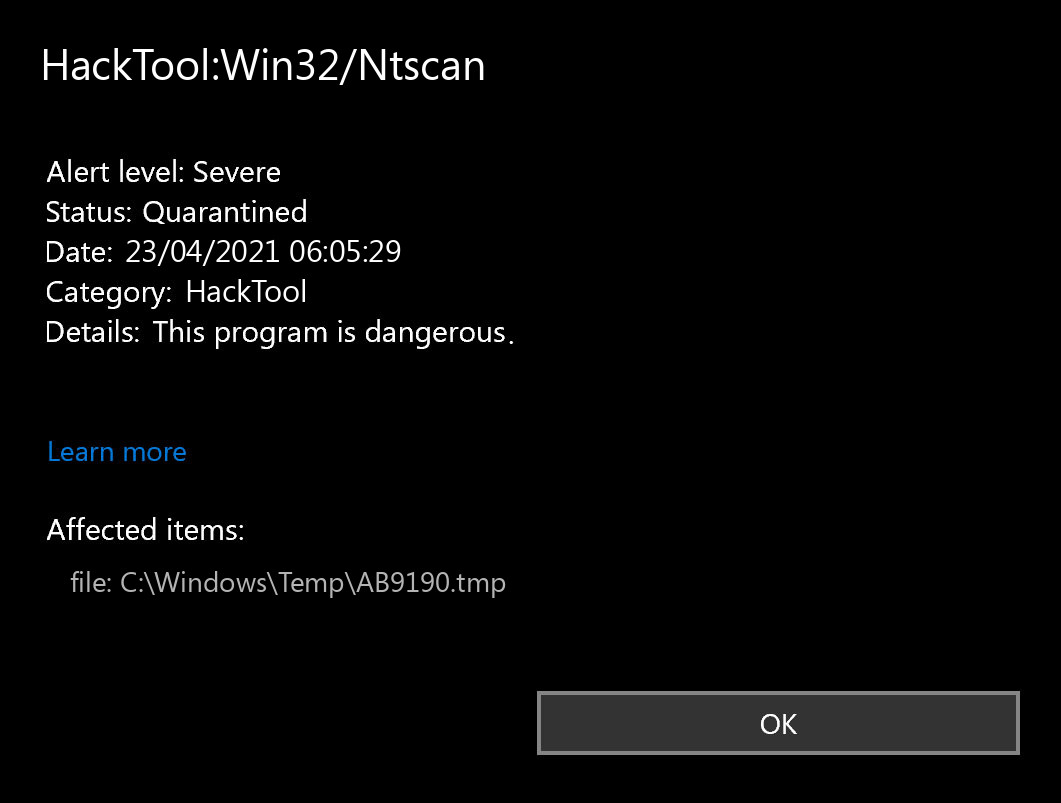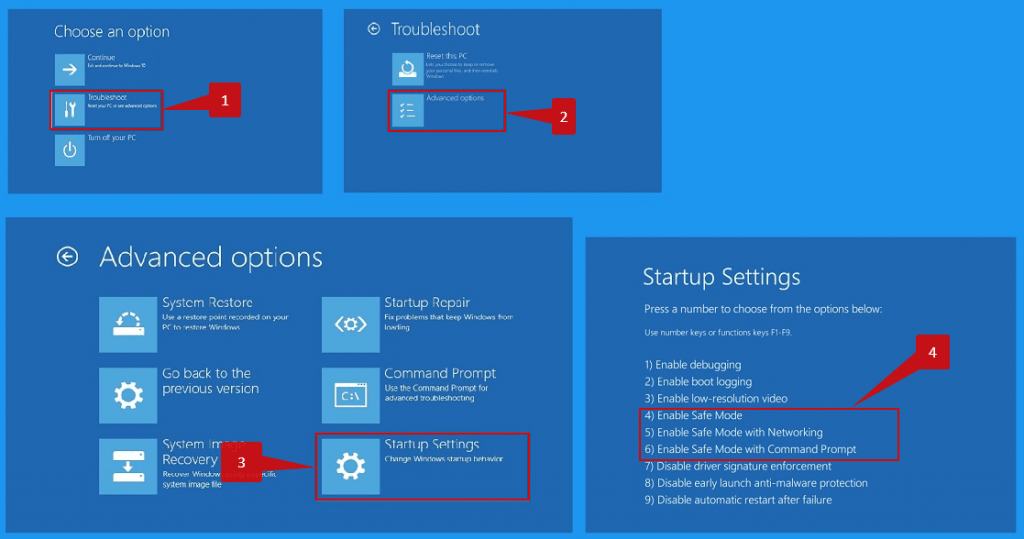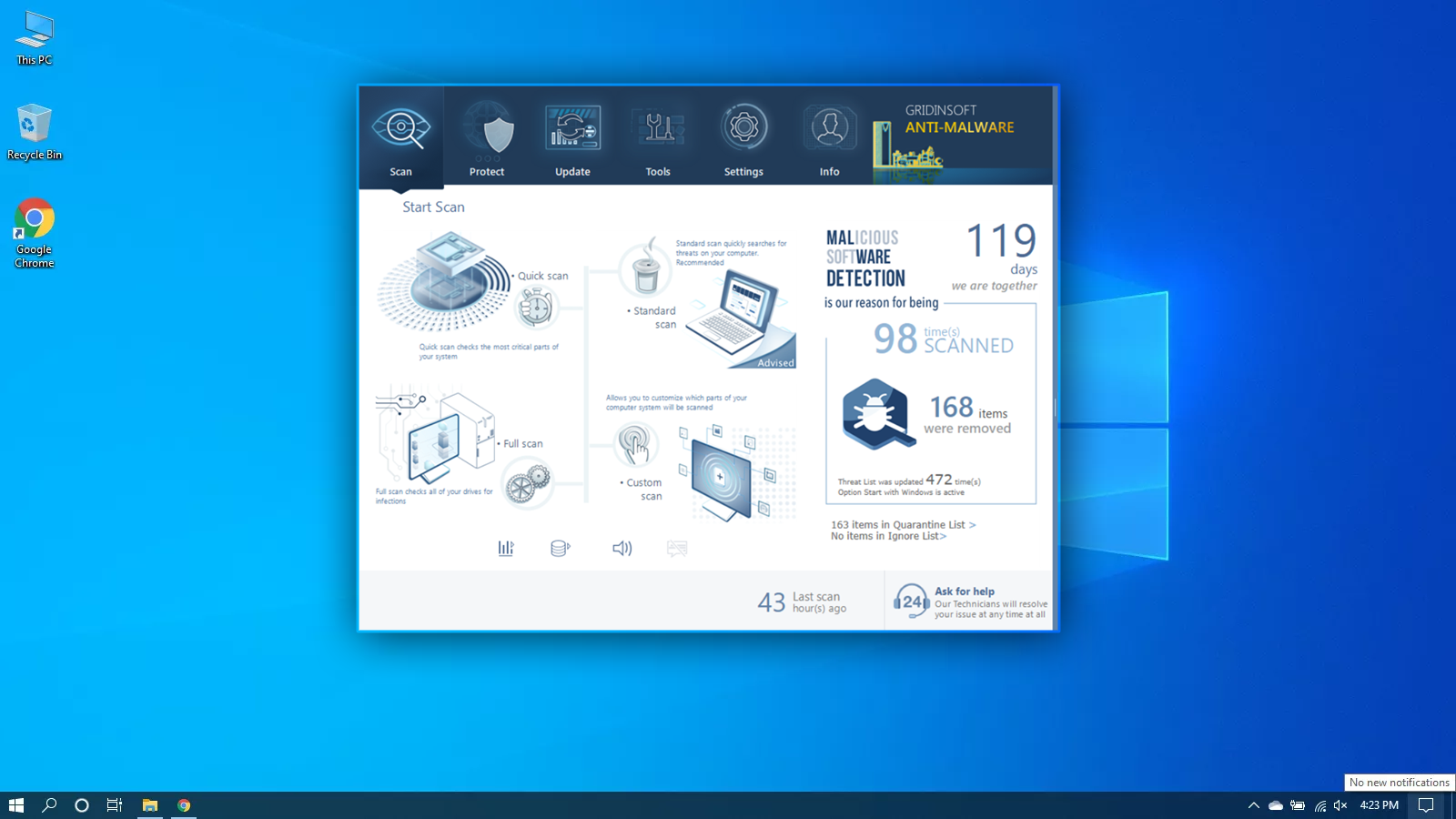HackTool:Win32/Ntscan is a detection name used by Microsoft Defender Antivirus to identify a potentially unwanted program (PUP) or tool that is designed to manipulate or exploit certain aspects of the Windows operating system for unauthorized purposes. These tools are not necessarily malware in themselves, but they can be misused by malicious actors to gain unauthorized access to systems or perform illegal activities.
HackTool:Win32/Ntscan and similar hack tools may include utilities for password cracking, network scanning, port scanning, keygens (key generators), and other tools that can be used to bypass security measures, crack software licenses, or perform other illicit actions. These tools are often used by hackers, crackers, or individuals with malicious intent to compromise systems, steal sensitive data, or gain unauthorized access to resources.
While some legitimate cybersecurity professionals and penetration testers may use hack tools for ethical hacking and security testing purposes, these tools can also be misused by cybercriminals. As a result, they are flagged by antivirus software like Microsoft Defender to prevent potential misuse and protect users from unauthorized activities on their systems.
It’s important to note that using hack tools for unauthorized purposes is illegal and can lead to serious consequences. Users should only use such tools in a legal and ethical manner, with proper authorization and for legitimate security testing or research purposes. If HackTool:Win32/Ntscan is detected on your system and you haven’t knowingly installed it or don’t have a legitimate need for it, it’s best to remove it to ensure the security and integrity of your computer.
What is HackTool:Win32/Ntscan?
Ntscan is a command-line tool that is part of the popular network scanning and enumeration toolset called “Nmap” (Network Mapper). Nmap is an open-source utility used for network exploration and security auditing. It was designed to rapidly scan large networks, but it works equally well against single hosts.
The Ntscan tool is specifically used to perform ping scans on hosts within a given network range. It sends ICMP echo request packets (ping) to multiple hosts to determine if they are online and responsive. By analyzing the responses received, Ntscan can help identify which hosts are active on the network.
Ntscan is a legitimate tool and is widely used by network administrators, security professionals, and penetration testers to perform network discovery, vulnerability assessment, and system auditing. It helps identify potential targets for further scanning or analysis and provides valuable information about the network’s topology.
However, it’s essential to use Ntscan and similar network scanning tools responsibly and with proper authorization. Unauthorized scanning of networks or hosts without permission is illegal and can lead to serious legal consequences. Therefore, it’s crucial to obtain the necessary permissions and adhere to ethical hacking guidelines when using tools like Ntscan to ensure the security and integrity of networks and systems.
Ntscan Summary
| Name | Ntscan HackTool |
| Detection | HackTool:Win32/Ntscan |
| Details | The Ntscan tool is specifically used to perform ping scans on hosts within a given network range. |
| Fix Tool | See If Your System Has Been Affected by Ntscan HackTool |
Does your antivirus regularly report about the “Ntscan”?
If you have actually seen a message showing the “HackTool:Win32/Ntscan found”, after that it’s an item of good information! The malware “HackTool:Win32/Ntscan” was identified and, probably, erased. Such messages do not mean that there was an actually energetic Ntscan on your device. You could have simply downloaded and install a data which contained HackTool:Win32/Ntscan, so your anti-virus software program automatically removed it before it was introduced and caused the troubles. Conversely, the harmful script on the infected site could have been identified as well as stopped prior to triggering any type of issues.
In other words, the message “HackTool:Win32/Ntscan Found” throughout the common use of your computer does not indicate that the Ntscan has completed its mission. If you see such a message after that it could be the evidence of you visiting the infected page or loading the destructive file. Try to prevent it in the future, yet don’t fret way too much. Try out opening the antivirus program as well as checking the HackTool:Win32/Ntscan discovery log file. This will certainly give you more info regarding what the specific Ntscan was found as well as what was especially done by your antivirus software application with it. Certainly, if you’re not positive enough, describe the hands-on scan– at any rate, this will be useful.
How to scan for malware, spyware, ransomware, adware, and other threats.
If your computer operates in an incredibly slow way, the websites open in an odd fashion, or if you see advertisements in the position you’ve never ever anticipated, it’s possible that your computer obtained contaminated and the virus is currently active. Spyware will track all your tasks or redirect your search or web page to the locations you don’t want to go to. Adware may contaminate your web browser as well as also the entire Windows OS, whereas the ransomware will attempt to obstruct your computer and require an incredible ransom quantity for your own files.
Regardless of the sort of trouble with your PC, the very first step is to scan it with Gridinsoft Anti-Malware. This is the best app to identify and also cure your PC. Nonetheless, it’s not an easy antivirus software. Its goal is to battle modern risks. Today it is the only product on the market that can simply cleanse the PC from spyware and other infections that aren’t also detected by routine antivirus programs. Download and install, install, as well as run Gridinsoft Anti-Malware, after that check your computer. It will certainly guide you through the system cleanup process. You do not need to purchase a license to cleanse your PC, the first license offers you 6 days of a completely cost-free trial. Nevertheless, if you wish to safeguard on your own from permanent hazards, you possibly need to consider acquiring the permit. By doing this we can ensure that your system will no more be infected with infections.
How to scan your PC for HackTool:Win32/Ntscan?
To examine your computer for Ntscan and to get rid of all spotted malware, you need to find an antivirus. The current versions of Windows include Microsoft Defender — the built-in antivirus by Microsoft. Microsoft Defender is generally fairly great, nonetheless, it’s not the only point you need. In our point of view, the most effective antivirus option is to make use of Microsoft Defender in combo with Gridinsoft.
In this manner, you may obtain complex defense versus the selection of malware. To look for pc virus in Microsoft Defender, open it and begin a new examination. It will extensively scan your computer for trojans. And also, obviously, Microsoft Defender works in the background by default. The tandem of Microsoft Defender and also Gridinsoft will set you free of most of the malware you could ever come across. A Routinely arranged scans might likewise secure your computer in the future.
Use Safe Mode to fix the most complex HackTool:Win32/Ntscan issues.
If you have HackTool:Win32/Ntscan type that can rarely be gotten rid of, you might need to think about scanning for malware past the typical Windows functionality. For this objective, you need to start Windows in Safe Mode, thus stopping the system from loading auto-startup items, perhaps including malware. Start Microsoft Defender examination and after that scan with Gridinsoft in Safe Mode. This will aid you uncover the viruses that can not be tracked in the routine mode.
Use Gridinsoft to remove Ntscan and other junkware.
It’s not sufficient to simply use the antivirus for the security of your PC. You require to have a more extensive antivirus service. Not all malware can be spotted by typical antivirus scanners that largely try to find virus-type risks. Your computer might contain “junk”, for instance, toolbars, web browser plugins, questionable internet search engines, bitcoin-miners, and various other sorts of unwanted software used for earning money on your lack of experience. Beware while downloading and install software online to prevent your gadget from being loaded with unwanted toolbars and other junk information.
Nonetheless, if your system has actually already obtained a specific unwanted application, you will certainly make your mind to delete it. The majority of the antivirus programs are uncommitted concerning PUAs (potentially unwanted applications). To eliminate such software, I suggest purchasing Gridinsoft Anti-Malware. If you use it regularly for scanning your computer, it will help you to eliminate malware that was missed by your antivirus software.
Frequently Asked Questions
There are many ways to tell if your Windows 10 computer has been infected. Some of the warning signs include:
- Computer is very slow.
- Applications take too long to start.
- Computer keeps crashing.
- Your friends receive spam messages from you on social media.
- You see a new extension that you did not install on your Chrome browser.
- Internet connection is slower than usual.
- Your computer fan starts up even when your computer is on idle.
- You are now seeing a lot of pop-up ads.
- You receive antivirus notifications.
Take note that the symptoms above could also arise from other technical reasons. However, just to be on the safe side, we suggest that you proactively check whether you do have malicious software on your computer. One way to do that is by running a malware scanner.
Most of the time, Microsoft Defender will neutralize threats before they ever become a problem. If this is the case, you can see past threat reports in the Windows Security app.
- Open Windows Settings. The easiest way is to click the start button and then the gear icon. Alternately, you can press the Windows key + i on your keyboard.
- Click on Update & Security
- From here, you can see if your PC has any updates available under the Windows Update tab. This is also where you will see definition updates for Windows Defender if they are available.
- Select Windows Security and then click the button at the top of the page labeled Open Windows Security.
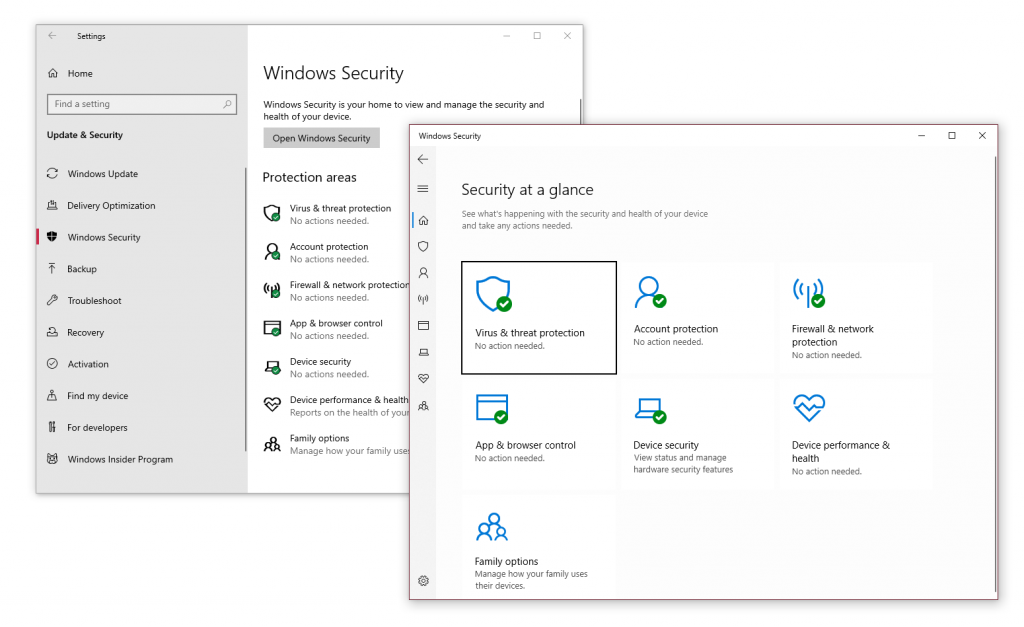
- Select Virus & threat protection.
- Select Scan options to get started.
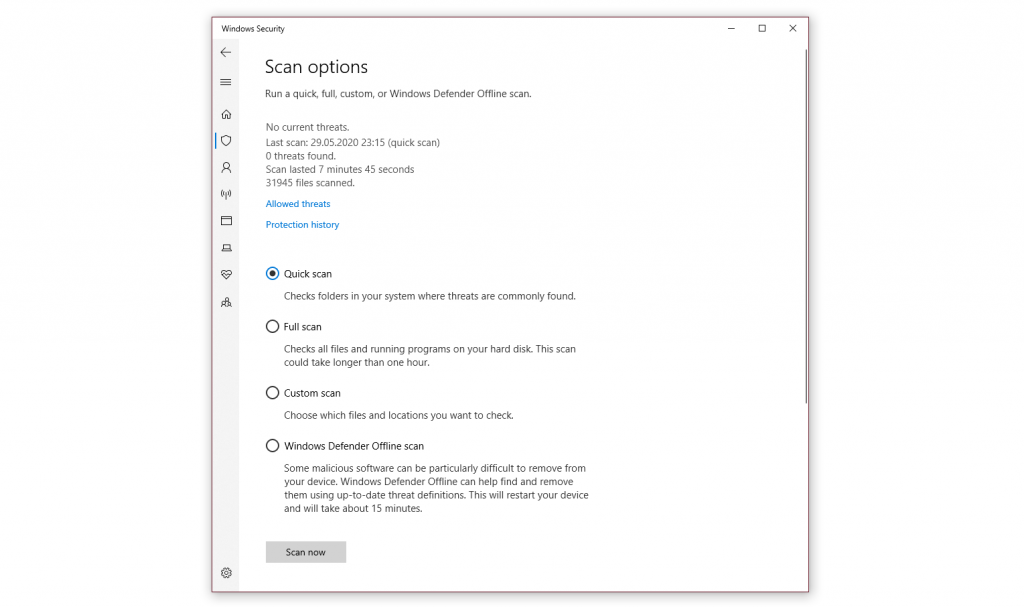
- Select the radio button (the small circle) next to Windows Defender Offline scan Keep in mind, this option will take around 15 minutes if not more and will require your PC to restart. Be sure to save any work before proceeding.
- Click Scan now
If you want to save some time or your start menu isn’t working correctly, you can use Windows key + R on your keyboard to open the Run dialog box and type “windowsdefender” and then pressing enter.
From the Virus & protection page, you can see some stats from recent scans, including the latest type of scan and if any threats were found. If there were threats, you can select the Protection history link to see recent activity.
If the guide doesn’t help you to remove HackTool:Win32/Ntscan virus, please download the GridinSoft Anti-Malware that I recommended. Also, you can always ask me in the comments for getting help. Good luck!
I need your help to share this article.
It is your turn to help other people. I have written this guide to help users like you. You can use buttons below to share this on your favorite social media Facebook, Twitter, or Reddit.
Wilbur WoodhamHow to Remove HackTool:Win32/Ntscan Malware
Name: HackTool:Win32/Ntscan
Description: If you have seen a message showing the “HackTool:Win32/Ntscan found”, then it’s an item of excellent information! The pc virus Ntscan was detected and, most likely, erased. Such messages do not mean that there was a truly active Ntscan on your gadget. You could have simply downloaded and install a data that contained HackTool:Win32/Ntscan, so Microsoft Defender automatically removed it before it was released and created the troubles. Conversely, the destructive script on the infected internet site can have been discovered as well as prevented prior to triggering any kind of issues.
Operating System: Windows
Application Category: HackTool


